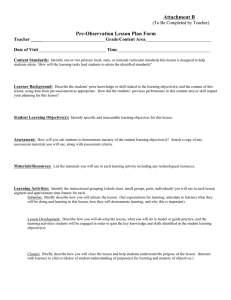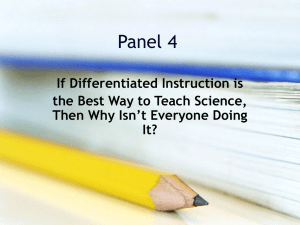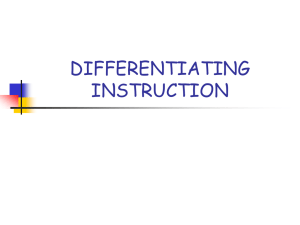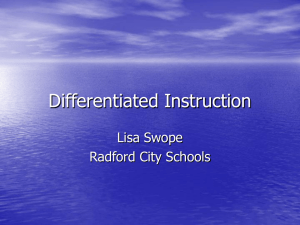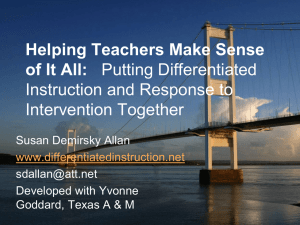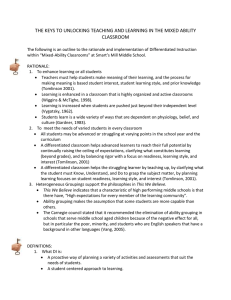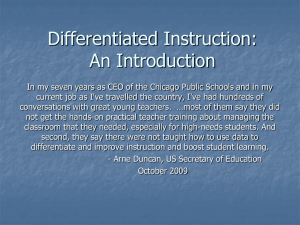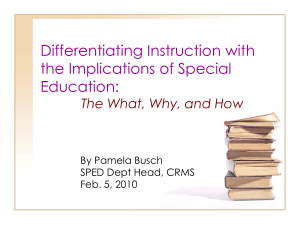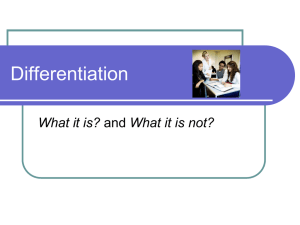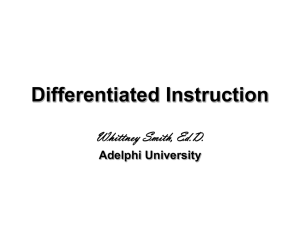Differentiating Instruction
advertisement
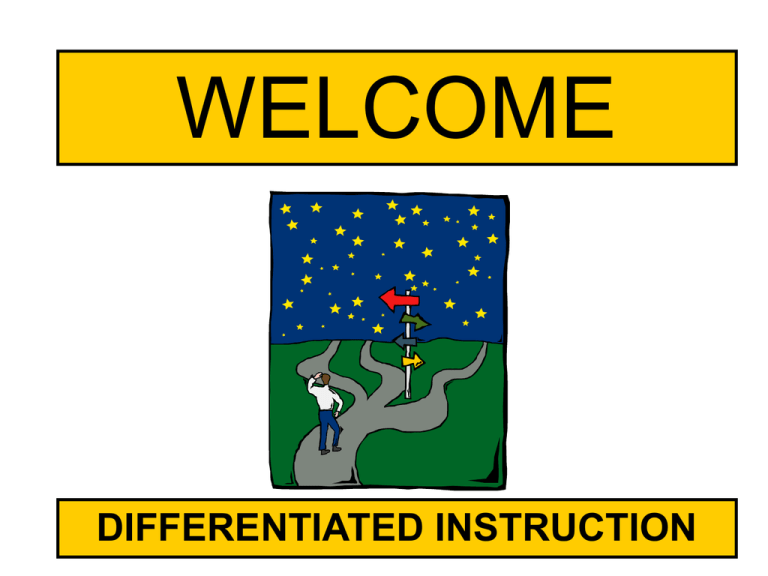
WELCOME DIFFERENTIATED INSTRUCTION Differentiating Instruction: The Journey "In the end, all learners need your energy, your heart and your mind. They have that in common because they are young humans. How they need you however, differs. Unless we understand and respond to those differences, we fail many learners." * Tomlinson, C.A. (2001). How to differentiate instruction in mixed ability classrooms (2nd Ed.). Alexandria, VA: ASCD. The biggest mistake of past centuries in teaching has been to treat all children as if they were variants of the same individual and thus to feel justified in teaching them all the same subjects in the same way. Howard Gardner Differentiated Instruction Means Recognizing Differences • There are no two students who learn at the same pace. • There are no two students who solve problems in exactly the same way. • There are no two students who have the same interests. • There are no two students who have learned the same skills. Differentiated Instruction Defined “Differentiated instruction is a teaching philosophy based on the premise that teachers should adapt instruction to student differences. Rather than marching students through the curriculum lockstep, teachers should modify their instruction to meet students’ varying readiness levels, learning preferences, and interests. Therefore, the teacher proactively plans a variety of ways to ‘get at’ and express learning.” Carol Ann Tomlinson Why Differentiate Instruction? When a teacher tries to teach something to the entire class at the same time, chances are, one-third of the students already know it; one-third will get it and the remaining third won’t. So two-thirds of the children are wasting their time. Lillian Katz Differentiation is a Way of Thinking About Teaching and Learning Differentiation Is a teacher’s response to learner’s needs Guided by general principles of differentiation Respectful tasks Flexible grouping Continual assessment Teachers Can Differentiate Through: Content Product Process Environment According to Students’ Readiness Interest Learning Profile Belief Statements from Education for All 1. All students can succeed. 2. Universal design and differentiated instruction are effective and interconnected means of meeting the learning or productivity needs of any group of students. 3. Successful instructional practices are founded on evidence-based research, tempered by experience. Belief Statements from Education for All 4. Classroom teachers are the key educators for a student’s literacy and numeracy development. 5. Each child has his or her own unique patterns of learning. 6. Classroom teachers need the support of the larger community to create a learning environment that supports all students. 7. Fairness is not sameness. Universal Design for Learning… • shapes teaching to provide all students with access to the curriculum (Turnbull et al., 2002) • assumes every student is unique, and will therefore benefit from a flexible curriculum that provides appropriate pathways for instruction, as well as fair and accurate assessment Universal Design for Learning… • encourages teachers to develop a class profile and then plan, from the beginning, to meet the needs of all students and not only those with special needs • helps eliminate ‘after the fact’ modifications • depends on flexibility and inclusion to provide real learning experiences for all students, regardless of their performance level Knowing the learners and consciously and strategically planning to address their styles, intelligences, and learning preferences will increase the chances of engaging them and offering a variety of ways to learn.” (Gregory and Chapman, 2002, p.35) Remember…… to think of DIFFERENTIATION as the lens you look through when using any materials, programs or instructional strategies. How will you use what you learn about today to differentiate for YOUR students?


